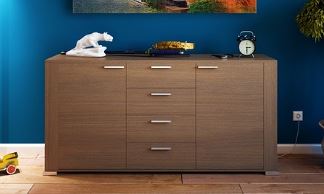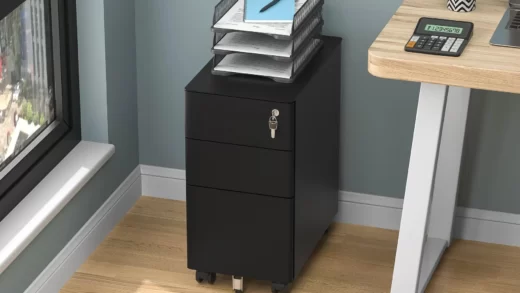Chalk paint on furniture because it is simple to distress and gives pieces a gently aged appearance. You don’t need to sand or prime the surface you’re painting, it’s a great choice when working on intricate furniture designs. Additionally, we introduce a guide for beginners to chalk paint on furniture and remove it if you don’t like it.
Table of Contents
What is Chalk Paint on Furniture?
You might be wondering what distinguishes chalk-style paint from conventional paint given its enormous popularity, which can be attributed in part to Pinterest. Chalk paint on furniture is easily identified by its supple, ultra-matte finish. The name comes from how it looks like a chalk-covered surface. The actual paint is latex-based, making it possible to clean up with water rather than mineral spirits. It also tends to be thicker and more manageable than standard paint.
Furthermore, it’s crucial to understand what chalk paint is not. Despite having a similar name, chalk paint is not the same as chalkboard paint, a well-liked specialty item that transforms any surface into a chalkboard so that you can write with chalk and then easily erase it. Although it has a different finish, chalk paint is more comparable to regular wall paint. Do not draw on your chalk paint because it might smudge.
What Materials Do You Need for Chalk Paint on Furniture?
Whatever the scale of your chalk paint on a furniture project, it’s a good idea to have a few materials to hand to help you prepare a surface for Chalk Paint:
- Cleaning cloth or sponge and warm soapy water
- Shellac or knotting solution
- Sanding pads
Do You Need to Sand Furniture before Using Chalk Paint?
When chalk paint on furniture with traditional paints, you must sand the surface first. The furniture paint from Annie Sloan will adhere to the majority of surfaces without any prior sanding. Since Chalk Paint® has such strong adhesion, most of the time there is no need to prepare the surface. Hardware can even be painted directly over if you so choose.
The only exception is if the surface in question is particularly shiny, like laminate. Make sure the paint has a textured surface to adhere to by lightly sanding this area.
If a surface is particularly damaged or uneven, some customers prefer to sand it first. If you want your painted finish to be particularly slick and contemporary in the end, this is something you might want to do. If your ultimate goal is to produce a textured or distressed paint finish, you shouldn’t really bother.
How do Chalk Paint on Furniture?
- Use a damp cloth to wipe down the surface of the piece of furniture to clean it before painting. Use warm, soapy water to remove tough grease and dirt; stay away from harsh chemicals.
- Sand the surface of glossy laminates using a sanding pad. Before painting, remove any sanding dust.
- Apply knotting solution to any knots or open grain before painting if the wood is new and untreated.
- Apply clear shellac or a stain blocker if you notice a stain coming through after you start painting. The stain can be removed with one or two evenly applied coats of shellac using a cloth pad. You can continue painting after it has dried in just a few minutes.
- It is essential to test a wooden floor before painting it. As soon as you apply varnish, stains and tannins can seep through the paint. Check out this tutorial first if you intend to paint your floorboards.
You’re prepared to handle any deviations from our “no sanding, no priming” tenet now that you understand how to prepare a surface for chalk paint on furniture. Most of the time, you won’t need to think twice about preparation, but if a minor issue does occur, you will be prepared. To achieve the most stunning, long-lasting painted finish, follow our instructions for preparing wood for Chalk Paint.
How Do I Remove Chalk Paint on Furniture?
“I’ve applied too much wax”, “Help! I’ve used too much Chalk Paint Wax – how do I fix it” and “how can I remove chalk paint on furniture” are frequent emails to the Team from Annie Sloan’s customer service. The best time to address this problem is right after you commit the error. You will notice opaque white lumps or streaks if you have applied too much wax. Simply remove with a lint-free cloth. You can still fix the problem if you overapplied Chalk Paint Wax and didn’t realize it until it had dried. White spirits and mineral spirits are sometimes recommended, but they contain harmful chemicals. Applying a new, thin coat of Chalk Paint Wax is the safest way to remove it. Contrary to popular belief, the oils in the new layer will “wake up” the underlying wax, making it simple to scrape off all of the excesses. Use a clean, absorbent cloth to gently wipe away the excess in a slow, steady motion. Keep extras on hand so you can swap out the current one when it becomes blocked with wax. Treat the piece as you would any freshly waxed furniture after all the excess has been taken off. After allowing to dry overnight, cure over the following few weeks.
Application Tips: Annie always uses her Wax Brush, packing a good amount of product onto it before applying in broad strokes. Before moving on to the next patch, she quickly moves the wax around and covers every square inch of the small area. The color of your furniture will be slightly darker where you’ve waxed, making it easy to see where you’ve done it.
How Much Does Chalk Paint Cost?
A small dresser can usually be painted with one quart of the original chalk paint from Annie Sloan, which costs about $42. However, there are other brands that sell similar products, including DecoArt’s Americana Decor line of “chalky finish” paints, which sell for around $8 per 8-ounce jar.
You can also create your own chalk paint if you’re feeling creative by combining regular latex paint and plaster from Paris. If you’re painting a large area, this might be a more economical option, but there is more room for error.
Is Chalk Paint Durable?
Whether chalk paint on furniture is strong enough to be used in high-traffic areas is one of the most frequently expressed worries about it. Yes, in a nutshell, but only if you spend the time to seal it properly. On tabletops and other surfaces that will see a lot of use, you might want to apply two or three coats of soft wax; just make sure to give the wax time to fully cure between coats. Annie Sloan paint is best covered with soft wax, which is advised when using the paint; you can also use the wax on other surfaces.
If you follow these instructions, your chalk paint will probably stay lovely for a number of years, though you can always re-wax the surface if it starts to look worn. As an alternative, you can seal your chalk paint with varnish or even polyurethane, and many people say that this technique improves durability. However, this might detract from the matte finish.
How to Prep Your Surface for Chalk Paint?
There are a few things to watch out for when chalk paint on furniture that has been prepared for painting. Is your surface especially greasy or dirty? Is the pine I’m painting brand-new or untreated? Is this an antique object dating from the 1930s or the 1940s? You’ll need to do some basic preparation if you said “yes” to any of these questions.
In order to help you prepare for painting, we’ve compiled a list of the supplies you’ll need as well as instructions on how to do things like clean, sand, or block stains.
Whenever you’re prepared to begin painting, make sure to follow all the steps above. Use them to do your chalk paint on furniture.



